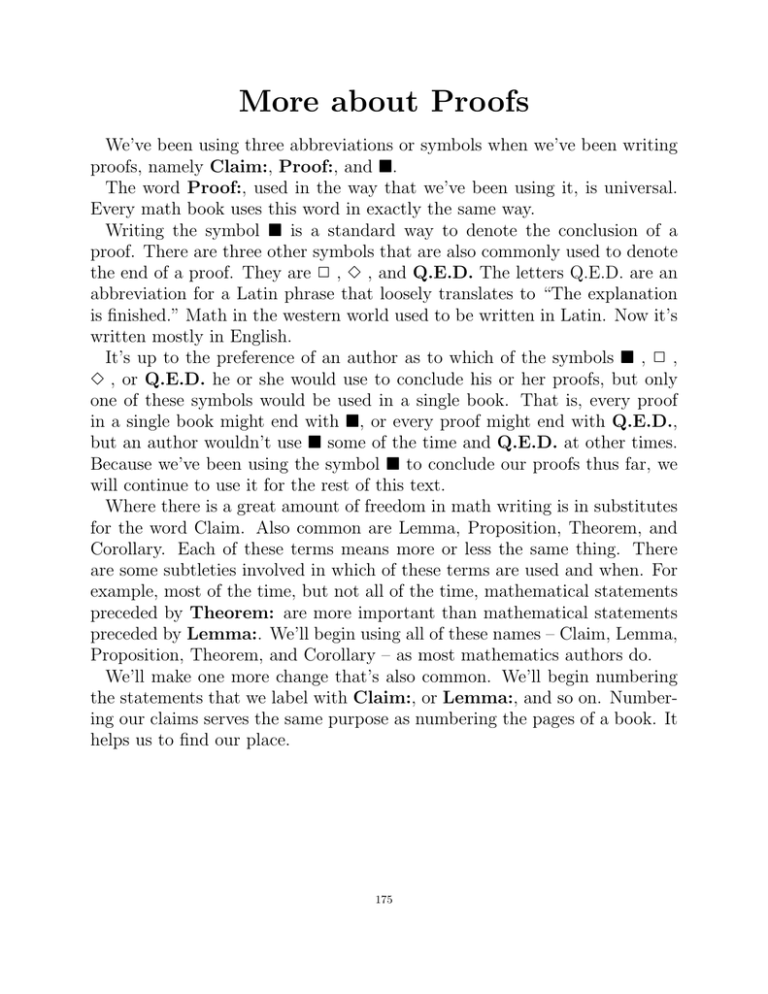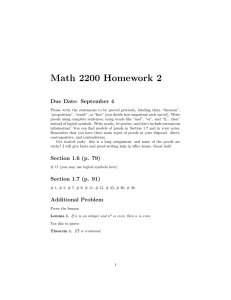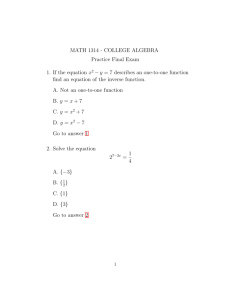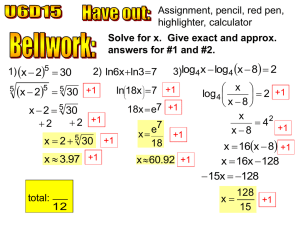More about Proofs
advertisement

More about Proofs We’ve been using three abbreviations or symbols when we’ve been writing proofs, namely Claim:, Proof:, and ⌅. The word Proof:, used in the way that we’ve been using it, is universal. Every math book uses this word in exactly the same way. Writing the symbol ⌅ is a standard way to denote the conclusion of a proof. There are three other symbols that are also commonly used to denote the end of a proof. They are 2 , 3 , and Q.E.D. The letters Q.E.D. are an abbreviation for a Latin phrase that loosely translates to “The explanation is finished.” Math in the western world used to be written in Latin. Now it’s written mostly in English. It’s up to the preference of an author as to which of the symbols ⌅ , 2 , 3 , or Q.E.D. he or she would use to conclude his or her proofs, but only one of these symbols would be used in a single book. That is, every proof in a single book might end with ⌅, or every proof might end with Q.E.D., but an author wouldn’t use ⌅ some of the time and Q.E.D. at other times. Because we’ve been using the symbol ⌅ to conclude our proofs thus far, we will continue to use it for the rest of this text. Where there is a great amount of freedom in math writing is in substitutes for the word Claim. Also common are Lemma, Proposition, Theorem, and Corollary. Each of these terms means more or less the same thing. There are some subtleties involved in which of these terms are used and when. For example, most of the time, but not all of the time, mathematical statements preceded by Theorem: are more important than mathematical statements preceded by Lemma:. We’ll begin using all of these names – Claim, Lemma, Proposition, Theorem, and Corollary – as most mathematics authors do. We’ll make one more change that’s also common. We’ll begin numbering the statements that we label with Claim:, or Lemma:, and so on. Numbering our claims serves the same purpose as numbering the pages of a book. It helps us to find our place. 175 Exercises Let S be the parabola that is the set of solutions of the equation y = x2 . Match each of the roman numbered subsets of the plane with its lettered picture and its arabic numbered equation. Exercises I.) A(3,1) (S) A.) For #1-8, write all polynomials in the form 1.) (y + 2) = (x S +Dx+Ey+F 2 Ax + Bxy+Cy 1 2.) Precompose the equation 2x 2 — 4.) Precompose the equation 2 + xy = — 4%) x+2 3.) II.) Precompose A(4, 2) (S) the equation B.) 3xy + y — = — y 1 — 2 2y = 3 4 with A( ). 19 2xy + y ). 93 2 with A( ( ). 1 witl 2.) (y + 1) = (x + 2)2 — 5y + 2 with (21 For #5-8, suppose that S is the set of solutions of the equation 0 III.) A( 2, 1) (S) 2 + xy + y 3x 2 = x — 3 — 54 y = £ y+3 — z 1.) Precompose the equation x 4)2 ) y+5 C.) 3.) (y 2) = (x + 3)2 IV.) A( 3,2) (S) D.) 4.) (y 1) = (x 3)2 For #5-8, use that the equation for S precoinposed with T’ is an equation for T(S). ‘1 5.) What is What is the equation for 176 S Write each of the numbers given in #5-11 as integers in standard form. For example, as 4, or 5 or 2. Remember that log4 (4x ) = x. 5.) log4 (45 ) 6.) log4 (437 ) 7.) log4 (42 ) 8.) log4 (16) 9.) log4 (64) 10.) log4 (4) 11.) log4 (1) 177





